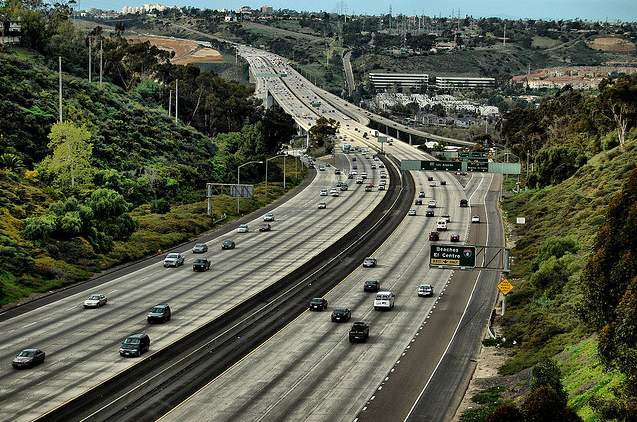Berkeley Law Amicus Brief Highlights Benefits of Transit-Oriented Development
Smart growth alternatives would help end the vicious cycle of highway expansion and housing sprawl in San Diego region
Berkeley Law’s Center for Law, Energy & the Environment (CLEE) filed an amicus brief last week in a California Court of Appeal case with far-reaching implications for development, transportation, and California’s climate goals. The case, Cleveland National Forest Foundation v. San Diego Association of Governments (SANDAG), challenges the State’s first Regional Transportation Plan/Sustainable Communities Strategy for its failure to properly analyze and mitigate environmental impacts, and its failure to consider viable alternatives that would have prioritized public transit and smart growth solutions over highway expansion. These alternatives would have further reduced greenhouse gas emissions and better prepared the region for sustainable, longterm growth.
Plaintiffs and the State of C alifornia argued in the trial court, and now on appeal, that SANDAG violated the California Environmental Quality Act (“CEQA”) in approving its 2050 Plan, the State’s first RTP/SCS prepared pursuant to SB 375, the Sustainable Communities and Climate Protection Act of 2008. SANDAG’s 2050 Plan designates all major transportation infrastructure that will be constructed in the San Diego region over the next 40 years. In adopting a Plan that emphasized expansion of San Diego’s freeway system—especially in the Plan’s earliest years—SANDAG rejected alternatives that would have substantially increased public transit in the region. These alternatives would have reduced the region’s dependency on automobiles and concentrated land use development in urbanized areas near city centers. In short, these smart growth alternatives would have helped end the vicious cycle of highway expansion and housing sprawl in the region.
alifornia argued in the trial court, and now on appeal, that SANDAG violated the California Environmental Quality Act (“CEQA”) in approving its 2050 Plan, the State’s first RTP/SCS prepared pursuant to SB 375, the Sustainable Communities and Climate Protection Act of 2008. SANDAG’s 2050 Plan designates all major transportation infrastructure that will be constructed in the San Diego region over the next 40 years. In adopting a Plan that emphasized expansion of San Diego’s freeway system—especially in the Plan’s earliest years—SANDAG rejected alternatives that would have substantially increased public transit in the region. These alternatives would have reduced the region’s dependency on automobiles and concentrated land use development in urbanized areas near city centers. In short, these smart growth alternatives would have helped end the vicious cycle of highway expansion and housing sprawl in the region.
Climate science, policy and law all make clear that California must reduce its greenhouse gas emissions in order to reduce the risk of catastrophic climate change. Land use planning and transportation play a prominent role in the reduction of greenhouse gas emissions. Indeed, passenger vehicles are the single largest source of greenhouse gas emissions statewide, accounting for more than 30% of total emissions. To help remedy this, SB 375 instructs the California Air Resources Board (CARB) to set regional emissions reduction targets from passenger vehicles. The Metropolitan Planning Organization for each region, in this case SANDAG, must then develop a “Sustainable Communities Strategy” (SCS) that integrates transportation, land-use and housing policies to plan for achievement of the emissions target for their region.
While the SANDAG Plan does acheive the 2035 emissions targets for the region, it does so largely due to the effects of the recession and fuel economy standards set by other agencies. As such, plaintiffs challenge the Plan pursuant to CEQA, rather than SB 375, for its failure to analyze viable alternatives that would avoid the significant environmental effects of the chosen RTP/SCS, in addition to other CEQA claims. While the Plan contains some transit components, it continues to fund and expand highways in the Plan’s earliest years, promoting housing sprawl over infill development.
Smart growth that takes the form of transit-oriented developed—mixed-use use development within walking distance of a transit station—is particularly likely to result in reduced automobile use, higher rates of public transit ridership and walking, and lower vehicle miles traveled (VMT) and greenhouse gas emissions. Directing growth to infill locations meets the increasing public demand for walkable communities, reduces traffic congestion and air pollution, preserves open space and protected habitat, and provides significant economic benefits to the region.
Our brief describes these benefits in more detail and cites several recent studies supporting these findings. We also analyze the legal requirement under CEQA to consider feasible smart growth alternatives that would reduce the environmental effects of SANDAG’s chosen plan, such as increased air pollution, greenhouse gas emissions, and traffic.
The amicus brief was filed on behalf of the Council of Infill Builders and the Planning and Conservation League (“PCL”), each progressive planning organizations with an interest in creating thriving, healthy communities.
The full suite of plaintiffs in this case are the Cleveland National Forest Foundation, Sierra Club, Center for Biological Diversity, CREED-21, Affordable Housing Coalition of San Diego County, with the People of the State of California (represented by the state Attorney General) as intervener. Petitioners prevailed in the trial court, and the case is now in the Court of Appeal, Fourth District.
Read the amicus brief here.







Reader Comments